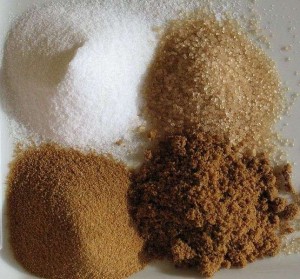Yesterday we talked about some good reasons to go grain-free. I figured I’d keep the nutrition-talk going and discuss sugar. I have my own sugar demons. They’ve gone pretty quiet since starting the Whole30, but I know they’re in there. This is a great reminder of why it’s best to avoid sugar when possible.
The Definitive Guide to Sugar (source: Mark’s Daily Apple)
Why Avoid Sugar?
Despite its beloved place (not to mention omnipresence) in our culinary culture, sugar offers the following gifts that keep on giving:
- Sugar stimulates a physiological stressor-reaction cascade that provokes adrenaline and cortisol release and thickens the blood.
- Sugar effectively disables your immune system by impairing white blood cells’ functioning.
- Sugar decreases your body’s production of leptin, a hormone critical for appetite regulation.
- Sugar induces significant oxidative stress in the body.
- Sugar appears to fuel cancer cells. (Check out Free the Animal for much more on the cancer connection.)
- Sugar promotes fat storage and weight gain.
- Sugar disrupts the effective transfer of amino acids to muscle tissue.
- Sugar intake over time spurs insulin resistance, subsequent Type II diabetes and the entire host of related health issues like nerve damage and cardiovascular disease.
Yes, sugar is one insanely powerful drug. Addictive, to boot.
Different Types of Sugar
Public service message aside, let’s get into the nitty-gritty now. Chemically speaking, there are different kinds of sugar. The natural sweeteners and sugary foods we eat contain varying proportions of these. Let’s look at a few of the most common forms.
Glucose
Glucose is the cornerstone of most carbohydrates. It’s a monosaccharide that often combines with and creates other forms of sugar (e.g. sucrose, lactose). In plants, glucose is formed through photosynthesis and stored as starch. In our own bodies, glucose is a precursor for (and product of) glycogen. It’s the common currency of carb-based fuels. In fact, our bodies manufacture glucose (through gluconeogenesis) when our blood levels get too low. Dextrose, a common isomer (same formula, different structure) of glucose, is also referred to as dextroglucose or glucose. Insulin directs glucose processing in the body when blood glucose is already sufficient or high. Glucose supply can be routed to cells throughout the body (e.g. brain cells, red blood cells, etc.) and used right away for energy, or it can be condensed and stored in both the liver and muscle as glycogen for later use. Maltose is a disaccharide joining two glucose molecules. Although it is significantly less sweet (about half of glucose’s sweetness), it is metabolized in the same way glucose is.
Fructose
Then there’s fructose, which is an isomer of glucose. It’s also called crystalline fructose, laevulose/levulose, or fruit sugar. (Crystalline fructose isn’t the same as the manufactured concoction called high fructose corn syrup. We’ll get to that one shortly.)
Some people have a harder time digesting fructose than others. Fructose (in the form of certain fruits, corn syrup, etc.) can cause everything from bloating to diarrhea in these folks. Some experts argue that fructose is a better choice for those with diabetes/insulin resistance because it’s more densely sweet, which encourages people to use less. It also has a lower glycemic value than glucose or sucrose. Indeed, fructose raises insulin less than glucose; however, fructose results in higher ghrelin levels, which boost rather than suppress appetite like insulin does. It also appears to throw off mineral levels (PDF) in the body. Finally, fructose is processed almost solely by the liver. There is some evidence that this concentrated burden on the liver over time can contribute to non-alcoholic fatty liver disease. The liver’s metabolism of fructose also produces uric acid, a predictor of cardiovascular disease. Fructose appears to be some pretty nasty stuff. For more information on fructose see Dr. Lustig’s video presentation, Sugar: The Bitter Truth, and then follow it up with a counter-perspective from Don Matesz: Paleo Basics: Fact vs. Fiction.
Sucrose
Sucrose is a disaccharide sugar comprised of fructose and glucose in a 1:1 ratio. It’s perhaps the most familiar of the sugars, since sucrose is also known as table sugar. Although it’s found in fruit and other plants (often with varying amounts of free fructose), sugar cane and sugar beets are the most popular sources for commercial production. Given that sucrose contains a large amount of fructose, it shows similar metabolic patterns to the monosaccharide fructose and particularly to high fructose corn syrup, which is commonly blended to an approximate 55% fructose: 45% glucose mixture.
Common Sugar Sweeteners
Now that we’ve covered the basics on the most common sugars, there’s the question of how all this plays out in our everyday choices. Clearly, we want to avoid sugar as a whole, but few of us achieve full sugar abstinence 100% of the time. Consider this run-through a quick and dirty snapshot of common sweeteners that can inform your decision-making.
Glucose Syrup/Corn Syrup
Glucose syrup in this country is usually made from corn, but it can be produced from other starches like potatoes and rice. Chemically speaking, true glucose syrup/corn syrup consists mainly of glucose sugar; however, some companies like Karo add fructose to their products. It’s commonly used as a sweetener plus emulsifier for food items that require a smooth texture like hard candy. Although glucose itself rates a 100 on the glycemic scale, corn syrup generally falls around 75.
HFCS
Like corn syrup, high fructose corn syrup (HFCS) is produced from corn starch; however, the manufacturing process deliberately converts a certain percentage of initial glucose into fructose. The two most common HFCS mixtures are HFCS-55 (containing 55% fructose) and HFCS-42, the former typically added to sodas and the latter added to other processed foods. The presence of fructose in HFCS appears to be key behind its myriad of negative health effects. Fructose content not only contributes to liver disease but lowers HDL levels while increasing small, dense (and more dangerous) LDL particles. As mentioned earlier, fructose also doesn’t flip the hormonal satiation switch as glucose does. Finally, the HFCS industry has been haunted by evidence of mercury contamination related to its production techniques.
Table Sugar/Sucrose
As mentioned, table sugar is actually a 1:1 combination of glucose and fructose and is metabolized in much the same way as HFCS. It’s GI measures around 64. One potential advantage of table sugar over HFCS is the absence of risk for mercury contamination.
Fruit Sugar
Even if you’ve sworn off adding sweetener of any kind to any food ever, there’s the question of fruit. Although the PB advises moderation and selectivity for most nutritional bang for the sugar buck, the best Primal fruits offer some of the highest ORAC values you can get from anything. Is it really necessary to swear off even nutritional powerhouses like berries and cherries to avoid their natural sugar content? The picture gets further complicated by the fact that “fruit sugar” doesn’t exist as a consistent chemical formula. Different fruits contain varying ratios of fructose, glucose and sucrose. Higher fructose-containing fruits include apples and pears, mangos and papaya, while relatively lower fructose fruits include cherries, figs, plums, kiwi, fresh and dried apricots, dried prunes and bananas. Keep in mind, however, that lower fructose ratio fruits can be higher in total sugar.
Raw Honey
Honey consists of dextrose and fructose (broken down from sucrose through honey bee’s digestion) in a nearly 1:1 ratio (with other components such as water, wax, nutrients, etc.). Raw honey has a glycemic index of about 30, but processed honey clocks in around 75. Those who have a harder time digesting fructose can often tolerate honey. Although conventional processing destroys much of honey’s natural benefits, raw honey serves up a (many claim therapeutic) dose of antioxidants, minerals, vitamins, amino acids, and enzymes.
Maple Syrup
Maple syrup is boiled and refined sap from maple trees. It has a GI of 54 and is low in free fructose but high in the fructose-glucose disaccharide sucrose. Nutritionally speaking, it contains manganese, iron and calcium.
Molasses
Although molasses has a fairly equal fructose-glucose ratio (half in free fructose/free glucose and half in disaccharide sucrose), it offers the nutrients extracted in table sugar production: iron, calcium, magnesium, potassium, phosphorus, copper and zinc.
Agave Nectar
The last few year have marked agave nectar’s time in the sun, so to speak. The sweetener has enjoyed growing popularity for some time, but experts are beginning to question whether agave nectar lives up to its reputation. Agave nectar is often heralded as low on the glycemic index (15), however, processing techniques result in a 75% or more fructose content. Given the increasing strikes against fructose, it’s harder to justify use of a higher fructose sweetener without significant nutritional benefit.
Palm Sugar/Coconut Sugar
An up and coming (in this country) sweetener is coconut sugar. The sugar is actually made from a variety of palm sources, but the palm and coconut labels are used (albeit mistakenly) interchangeably. It’s largely sucrose-based and registers in the 30s/40s on the GI. The taste is relatively light from what I understand, and the nutritional profile is worth noting.
There you go, folks. Information is power when it comes to your health, and I hope this list offered good food for thought. Here’s my analysis. When you are choosing whether/how to include sugars in your Primal diet, I’d suggest paying closest attention to the total sugar content first, then to any nutritional benefits, and finally to the fructose content. Blueberries might have a relatively equal fructose/glucose ratio, but they offer huge antioxidant benefit. On the other hand, dried apricots have a lower fructose ratio, but their overall sugar content dwarfs many fruits ounce for ounce. Raw honey and coconut sugar likewise offer solid nutritional benefit for their sugar content compared to other sweeteners. Of course, any sugar should be used in strict moderation, but it’s clear not all sweeteners are Primally equal.
Read more: http://www.marksdailyapple.com/the-definitive-guide-to-sugar/#ixzz1j0Lxh7LF




rickyfatts says
What about a natural sugar substitute like Stevia? And how bad are all those artificial substitutes like saccharin, aspartame etc?
radlandon says
Ricky, I haven’t investigated artificial sweeteners much yet, as I have never used them. I’ll look into them, though!
Sara says
Hi there,
Congrats for your blog! I sent a link from my blog to your thorough sugar description as I’ve just published an article about avoiding sugar….
I like your clean eating suggestions!
All the best,
Green Addict
radlandon says
Thanks Sara! I’ll check out your blog!